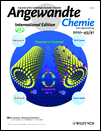Telomeres and Telomerase: The Means to the End (Nobel Lecture)†
Prof. Elizabeth H. Blackburn
Department of Biochemistry and Biophysics, The University of California San Francisco, San Francisco, CA 94158 (USA)
Search for more papers by this authorProf. Elizabeth H. Blackburn
Department of Biochemistry and Biophysics, The University of California San Francisco, San Francisco, CA 94158 (USA)
Search for more papers by this authorCopyright© The Nobel Foundation 2009. We thank the Nobel Foundation, Stockholm, for permission to print this lecture.
Graphical Abstract
Secrets revealed: The Nobel Prize for Medicine 2009 was awarded for the solution to one of the greatest mysteries of biology: how are chromosomes copied upon cell division and protected from degradation? The answer can be found at the ends of the chromosomes—the telomeres—and in the enzyme that forms them—telomerase. The laureates describe the events leading to the discovery first-hand.
References
- 1 Telomeres, 2nd ed. ), Cold Spring Harbor Press, Cold Spring Harbor, NY, 2006, pp. 1–19.
- 2“Cytological observations of deficiencies involving known genes, translocations and an inversion in Zea mays”: B. McClintock, Agricultural Experiment Research Station Bulletin, University of Missouri College of Agriculture, 1931, 163, 4–30.
- 3“A correlation of ring-shaped chromosomes with variegation in Zea Mays”: B. McClintock, Proc. Natl. Acad. Sci. USA 1932, 18, 677–681.
- 4“The remaking of chromosomes”: G. Muller, Collecting Net 1938, 8, 182–195.
- 5“Chromosome-sized DNA molecules from Drosophila”: R. Kavenoff, Chromosoma 1973, 41, 1–27.
- 6K. Grell, Protozoology, Springer, Berlin, 1973.
10.1007/978-3-642-61958-8 Google Scholar
- 7“A tandemly repeated sequence at the termini of the extrachromosomal ribosomal RNA genes in Tetrahymena”: E. Blackburn, J. C. Gall, J. Mol. Biol. 1978, 120, 33–53.
- 8“The molecular structure of centomeres and telomeres”: E. Blackburn, J. Szostak, Annu. Rev. Biochem. 1984, 53, 163–194.
- 9“Tandemly repeated C-C-C-C-A-A hexanucleotide of Tetrahymena rDNA is present elsewhere in the genome and may be related to the alteration of the somatic genome”: M. Yao, E. Blackburn, J. Gall, J. Cell Biol. 1981, 90, 515–520.
- 10“Telomeres and their Synthesis”: E. Blackburn, Perspect. Sci. 1990, 249, 489–490.
- 11“A family of inverted repeat sequences and specific single-strand gaps at the termini of the Physarum rDNA palindrome”: E. Johnson, Cell 1980, 22, 875–886.
- 12“An irregular satellite sequence is found at the termini of the linear extrachromosomal rDNA in Dictyostelium discoideum”: H. Emery, A. Weiner, Cell 1981, 26, 411–419.
- 13“Sequence-specific fragmentation of macronuclear DNA in a holotrichous ciliate”: G. Katzen, G. Cann, E. Blackburn, Cell 1981, 24, 313–320.
- 14“Tandemly repeated hexanucleotide at Tetrahymena rDNA free end is generated from a single copy during development”: B. King, M. Yao, Cell 1982, 31, 177–182.
- 15“DNA termini in ciliate macronuclei”: E. Blackburn, et al., Cold Spring Harbor Symp. Quant. Biol. 1983, 0, 0.
- 16“Inverted terminal repeats are added to genes during macronuclear development in Oxytricha nova”: R. Boswell, L. Klobutcher, D. Prescott, Proc. Natl. Acad. Sci. USA 1982, 79, 3255–3259.
- 17“Cloning yeast telomeres on linear plasmid vectors”: J. Szostak, E. Blackburn, Cell 1982, 29, 245–255.
- 18“DNA sequences of telomeres maintained in yeast”: J. Shampay, J. Szostak, E. Blackburn, Nature 1984, 310, 154–157.
- 19“Growth of chromosome ends in multiplying trypanosomes”: A. Bernards, et al., Nature 1983, 303, 592–597.
- 20“Identification of a specific telomere terminal transferase activity in Tetrahymena extracts”: C. W. Greider, E. H. Blackburn, Cell 1985, 43, 405–413.
- 21“The telomere terminal transferase of Tetrahymena is a ribonucleoprotein enzyme with two distinct primer specificity”: C. Greider, E. Blackburn, Cell 1987, 51, 887–898.
- 22“A telomeric sequence in the RNA of Tetrahymena telomerase required for telomere repeat synthesis”: C. Greider, E. Blackburn, Nature 1989, 337, 331–337.
- 23“In vivo alteration of telomere sequences and senescence caused by mutated Tetrahymena telomerase RNAs”: G.-L. Yu, et al., Nature 1990, 344, 126–132.
- 24“Switching and signaling at the telomere”: E. Blackburn, Cell 2001, 106, 661–673.
- 25“Telomeres and telomerase. Inter-species comparisons of genetic, mechanistic and functional aging changes”: N. Gomes, J. Shay, W. Wright in The Comparative Biology of Aging (Ed.: ), Springer, Dordrecht, 2010, pp. 227–258.
- 26“Association between telomere length, specific causes of death, and years of healthy life in health, aging, and body composition, a population-based cohort study”: O. Njajou, et al., J. Gerontol. Ser. A 2009, 64, 860–864.
- 27“Accelerated telomere shortening in response to life stress”: E. Epel, et al., Proc. Natl. Acad. Sci. USA 2004, 101, 17312–17315.
- 28“Cell aging in relation to stress arousal and cardiovascular disease risk factors”: E. Epel, et al., Psychoneuroendocrinology 2006, 31, 277–287.
- 29“Analyses and comparisons of telomerase activity and telomere length in human T and B cells: insights for epidemiology of telomere maintenance”: J. Lin, et al., J. Immunol. Methods 2010, 352, 71–80.
- 30“Dynamics of telomerase activity in response to acute psychological stress”: E. S. Epel, J. Lin, F. S. Dhabhar, O. M. Wolkowitz, E. Puterman, L. Karan, E. H. Blackburn, Brain Behav. Immun. 2010, 4, 531–539.





